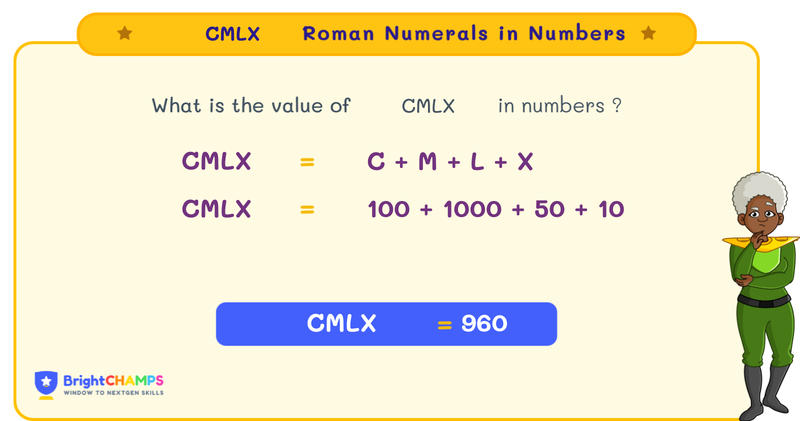
 174 Learners
174 LearnersLast updated on May 26th, 2025

CMLX in Roman Numerals

To meet their daily commerce and administration needs, the ancient Romans developed Roman Numerals. It used a combination of seven symbols — I, V, X, L, C, D, and M to represent numbers. Roman numerals were used to record transactions, keep track of data, and label military units. In this topic, we are going to learn about the Roman numeral CMLX.
What is CMLX in Roman Numerals?
Ancient Romans discovered that counting fingers could get very complicated after 10. So to overcome the complexity, the Roman numeric system was developed. This was widely used throughout Europe as a standard writing system until the late Middle Ages.
Seven symbols are used to represent numbers in the Roman numeric system — I, V, X, L, C, D, and M. The numerals are made up of different combinations of these symbols. CMLX in Roman numerals can be written in number form by adding and subtracting the values of each Roman numeral, i.e. CMLX = 960.
Let us learn more about the Roman numeral CMLX, how we write them, the mistakes we usually make, and ways to avoid these mistakes.

Basic Rules for CMLX in Roman Numerals
When writing Roman numerals, there are a few rules that we need to follow based on the Roman numerals we are trying to write. In this section, we will learn about the rules when writing Roman numerals and how to represent them.
Rule 1: Addition Method:
When a larger symbol is followed by a smaller symbol, we add the numerals to each other. For example, in XI, we have 10 + 1 = 11.
Rule 2: Repetition Method:
A symbol that is repeated three times in continuation increases the value of the numeral. For example, CCC = 300.
Rule 3: Subtraction Method:
We use the subtraction method when a larger symbol follows a smaller symbol. For example, XL = 40 (which is 50 – 10).
Rule 4: Limitation Rule:
Symbols cannot be repeated more than three times, and some symbols, such as V, L, and D, cannot be repeated more than once. For example, 10 is represented as X and not VV.
How to Write CMLX in Roman Numerals?
Let us learn about how to write CMLX in Roman numerals. There are two methods that we can use to write Roman numerals:
- By Expansion Method
- By Grouping Method
CMLX in Roman Numeral by Expansion Method
The breaking down of Roman numerals into parts and then converting them into numerals is what we call the expansion method. The expansion method is the breaking down of Roman numerals into numerical form and adding them to get the final number.
Step 1: Break the Roman numerals into parts.
Step 2: Now write each of the Roman numerals with its numerical digit in the place value.
Step 3: Add or subtract the numerals together.
For CMLX, Step 1: First we break the Roman numerals. CMLX = CM + L + X
Step 2: Write the Roman Numerals for each part
The Roman Numeral CM is 900
The Roman Numeral L is 50
The Roman Numeral X is 10
Step 3: Combine all the numbers CM + L + X = 900 + 50 + 10 = 960 Therefore, the Roman Numeral CMLX is 960.
CMLX in Roman Numeral by Grouping Method
Using subtraction and addition rules, we will apply the grouping method. This means we break the Roman numerals into smaller groups, which makes it easier to work with. This method groups the Roman numerals logically, and then we write the numbers for each group.
Step 1: Take the largest number and write the number for that Roman numeral.
Step 2: Write the Roman numeral using the subtraction and addition rules.
Example: Let’s take the Roman numeral CMLX.
Step 1: The larger Roman numerals are what we will begin with. Once split, the Roman numerals we get are CM and LX. The numeral for CM is 900.
Step 2: Now we need to either add or subtract the smaller number, depending on its place.
Here we add LX to CM and we will get CMLX. The Roman numeral LX is 60. Therefore, the numeral of CMLX is 960.

Common Mistakes and How to Avoid Them in CMLX Roman Numerals
Students can make mistakes when studying Roman numerals. Here are a few common mistakes students make, and ways to avoid them.

CMLX Roman Numerals Examples

Problem 1
If a Roman soldier receives a reward of CMLX denarii each year, how much would he receive in three years? Write the answer in Roman numerals.

The total amount is MCMXXX
Explanation
Convert CMLX into its decimal form:
CMLX = 960
Multiply by 3 to find the total for three years: 960 × 3 = 2880
Convert 2880 into Roman numerals: 2000 (MM) + 800 (DCCC) + 80 (LXXX) = MCMXXX

Problem 2
A merchant has CMLX pieces of fabric and sells CXL. How many pieces are left? Write the answer in Roman numerals.

The remaining pieces are DCCCXX
Explanation
Convert the Roman numerals into their decimal form:
CMLX = 960
CXL = 140
Subtract the sold pieces from the total: 960 - 140 = 820
Convert 820 into Roman numerals: 800 (DCCC) + 20 (XX) = DCCCXX

Problem 3
Divide CMLX by IV and express the answer in Roman numerals.

CCXL
Explanation
Convert CMLX into its decimal form:
CMLX = 960
Divide by 4: 960 / 4 = 240
Write 240 in Roman numerals: 200 (CC) + 40 (XL) = CCXL

Problem 4
Calculate the product of CMLX and II. Provide the answer in Roman numerals.

The product is MCMXX
Explanation
Convert CMLX and II into numbers:
CMLX = 960
II = 2
Multiply the numbers: 960 × 2 = 1920
Convert 1920 into Roman numerals: 1000 (M) + 900 (CM) + 20 (XX) = MCMXX

Problem 5
Convert CMLX into its decimal form.

In decimal form, CMLX is 960
Explanation
Break CMLX into components: CM = 900 LX = 60 Add values: 900 + 60 = 960


FAQs on CMLX in Roman Numerals
1.What is LX in Roman numerals?
2.Is CMLX a prime number?
3.What is CMLX + CMLX?
4.What is CMX?
5.Subtract LX from CMLX
6.How can children in Qatar use numbers in everyday life to understand CMLX in Roman Numerals?
7.What are some fun ways kids in Qatar can practice CMLX in Roman Numerals with numbers?
8.What role do numbers and CMLX in Roman Numerals play in helping children in Qatar develop problem-solving skills?
9.How can families in Qatar create number-rich environments to improve CMLX in Roman Numerals skills?
Important Glossaries for CMLX in Roman Numerals
- Subtraction Method: A method used when a smaller numeral precedes a larger numeral, indicating subtraction.
- Addition Method: A method used when larger numerals precede smaller numerals, indicating addition.
- Repetition Method: A method where symbols are repeated up to three times to increase their value.
- Place Value: The numerical value that a digit has by virtue of its position in a number.
- Non-repeatable Symbols: Symbols that cannot be repeated, such as V, L, and D.
Explore More numbers


Hiralee Lalitkumar Makwana
About the Author
Hiralee Lalitkumar Makwana has almost two years of teaching experience. She is a number ninja as she loves numbers. Her interest in numbers can be seen in the way she cracks math puzzles and hidden patterns.
Fun Fact
: She loves to read number jokes and games.




